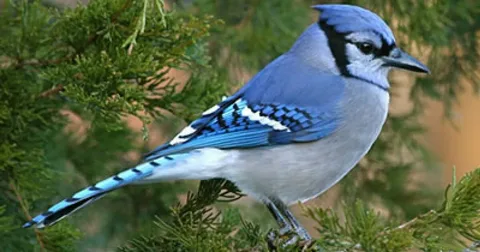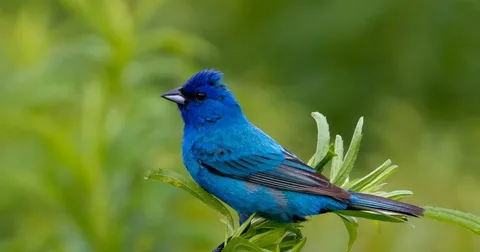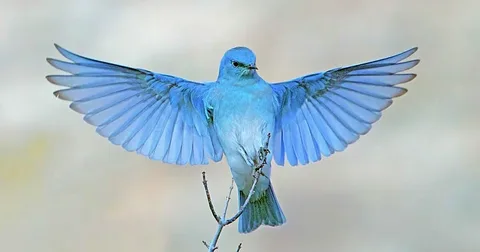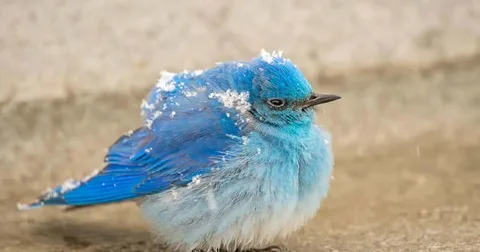Mountain Blue birds Graceful Nature’s Sky-Colored Jewel
1. Introduction to the Mountain Blue Birds

Mountain Blue Birds (Sialia currucoides) is a small, delicate songbird known for its striking sky-blue plumage and gentle demeanor. Often described as one of the most beautiful birds in North America, it holds a special place in the hearts of birdwatchers, photographers, and nature lovers. These birds are widely admired not only for their vibrant coloration but also for their symbolic association with joy, hope, and renewal. Found in open habitats across western North America, Mountain Blue Birds stand out as dazzling figures against the backdrop of rolling meadows, prairies, and high-altitude landscapes. Their presence often signals the arrival of spring, making them a cherished seasonal marker.
2. Mountain Blue Birds Physical Appearance and Unique Features

Mountain Blue Birds are especially eye-catching with their brilliant turquoise-blue feathers, which shimmer in the sunlight. The shade of blue can vary slightly depending on light conditions, ranging from pale sky-blue to deeper azure tones. Their undersides are often whitish or slightly gray, providing a gentle contrast to their vibrant wings and back. Females, on the other hand, are less brightly colored, displaying softer shades of grayish-brown with hints of blue on their wings and tail. This subtle coloration helps them blend into their surroundings, offering camouflage when nesting. Despite their modest size—measuring about 6 to 7 inches long—they exude elegance and grace in every movement, whether perched quietly on a fence post or fluttering above grasslands.
3. Habitat and Distribution Mountain Blue Birds
Mountain Blue Bird thrive in open, treeless habitats such as prairies, grasslands, and alpine meadows. Unlike many other songbirds that prefer dense forests, these birds seek wide, open spaces that provide clear visibility and easy access to insects, their primary food source. During the breeding season, they are most commonly found in western regions of North America, including Alaska, Canada, and the Rocky Mountains. In the winter months, they migrate southward, reaching as far as Mexico. Their adaptability to high elevations makes them unique among bluebird species. This ability to endure diverse landscapes showcases their resilience and strength as a species.
4. Diet and Feeding Behavior

The diet of Mountain blue bird is primarily insect-based, especially during the warmer months when food sources are abundant. Grasshoppers, beetles, caterpillars, and spiders make up a significant portion of their meals. These birds are skilled hunters, often perching on low posts or branches and darting out swiftly to snatch insects mid-air. During colder seasons when insects are scarce, mountain bluebirds shift their diet to include berries and small fruits, such as elderberries and juniper berries. This seasonal flexibility ensures their survival even in regions with limited resources. Their feeding habits also play an ecological role, helping control insect populations and dispersing seeds that support plant growth.
5. Breeding, Nesting, and Family Life
Breeding season for mountain bluebirds typically begins in late spring. Males attract females through a combination of song, flight displays, and by showing potential nesting sites. They prefer nesting in natural cavities, such as old woodpecker holes, but they readily adapt to man-made nest boxes as well. Once paired, the female takes the lead in constructing the nest using grass, pine needles, and other soft materials. A clutch usually contains four to six pale blue eggs, which the female incubates for about two weeks. After hatching, both parents share the responsibility of feeding the chicks until they fledge, usually within three weeks. Conservation efforts, such as the placement of bluebird trails with nest boxes, have played a significant role in sustaining their populations.
6. Symbolism, Conservation, and Human Connection Mountain Blue Birds

Its brilliant blue feathers evoke feelings of peace and serenity, often appearing in folklore, poetry, and even state emblems. For example, the mountain bluebird is the official state bird of Idaho and Nevada, representing beauty and resilience. However, despite their charm, these birds face challenges from habitat loss, climate change, and competition with invasive species such as European starlings and house sparrows. Thankfully, dedicated conservation programs and community initiatives have helped stabilize their populations. The widespread use of nest boxes, public education, and habitat preservation have all contributed to their protection. Their presence continues to inspire appreciation for wildlife and motivates people to safeguard the natural world.
Conclusion
The mountain bluebird is far more than just a pretty creature; it is a vital part of the ecosystem, a symbol of hope, and a testament to nature’s brilliance. From their radiant plumage to their resourceful survival strategies, these birds embody resilience and grace. Whether soaring over high-altitude meadows or perching quietly on a fence post, mountain bluebirds remind us of the delicate balance of life and the importance of protecting the environments we share with them. By conserving their habitats and respecting their presence,
 Birds Drawing Birds Drawing
Birds Drawing Birds Drawing




